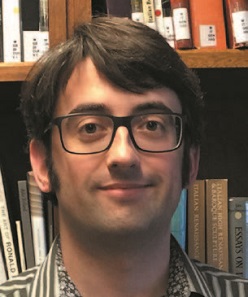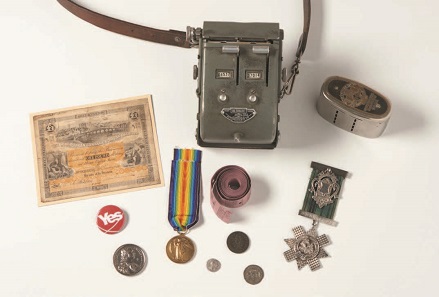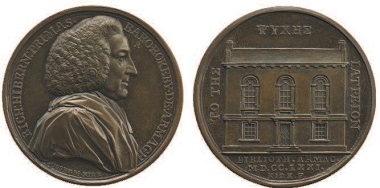By Henry Flynn
June 21, 2018 – The latest temporary exhibition in the British Museum’s Room 69a is called Money and medals: mapping the UK’s numismatic collections. It focuses on the work of the Money and Medals Network and as well as being a chance to celebrate the work conducted so far, it represents an excellent opportunity to demonstrate the geographical spread of its collections mapping project. The exhibition showcases the collections of six MMN participants. The selection includes a local history museum in Scotland, a stately home in the North West of England, an 18th century library in Northern Ireland, a military museum in Wales and both a national and independent museum in London. This reflects the extent of the Network itself but also illustrates the range and diversity of numismatic collections that are available for the public to see.
Henry Flynn, one of the exhibition’s promoters.
“I have had the pleasure of working with a number of people from these lending institutions and together we have created an exhibition that invites the museum visitor to learn more about the subject of numismatics and to see six very different types of numismatic collection. I would like to thank them all for their generosity, enthusiasm and support of this exhibition,” promoter Henry Flynn says.
Katy Barett
The Science Museum
By Katy Barrett, Curator of Art Collections
The Science Museum collections include a set of 7 frames of electrotype coins arranged in periods, BC 700-1. They are copies of coins in the British Museum produced initially for the V&A and in the collections there from 1894. The set was most likely produced in the 1860s in response to the initiative of V&A director Henry Cole to make heritage available internationally through copies. The Ready family – father Robert, and later sons Charles Joseph and Augustus Papworth – worked for the British Museum making such copies from the 1860s.
Framed electrotypes as exhibited in The Science Museum. Photo: Henry Flynn.
In their first guise at the V&A, these electrotypes demonstrated the ‘decline’ of art in the design of Greek coins. Transferred to the Science Museum in 1946 they represented an example for the metallurgy collections of the electrotype process. Later they moved to the Coins, Medals and Tokens collection, joining an important group of material that reflects the role of these objects in the history of science, technology and medicine. This includes coin production, and industrial tokens, as well as commemorative and award medals.
It is important for the Science Museum to be part of the Money and Medals Network to increase visibility and appreciation of these collections. The museums says they were delighted to loan to the exhibition the final frame of electrotypes entitled ‘Late Decline of Art, Period VII, Circa B.C.100-1’, which is the only one inscribed with the relationship to both Ready and the British Museum collections. It is a perfect example of how museums across the UK have long supported each other’s numismatic efforts and continue to do so.
Military and civil items representing Scotland. Photo: Inverness Museum and Art Gallery
Inverness Museum and Art Gallery
By Kari Moodie, Curator (Collections), Inverness Museum and Art Gallery
Inverness Museum & Art Gallery is very proud to be MMN’s most northerly member. IMAG’s collections are extremely varied and numismatics play an important role spanning archaeology, social history and decorative arts. For this exhibition, the museum wanted the exhibits to reflect objects that are both typically found in municipal collections yet special for their local relevance.
Jacobites and bagpipes are known across the world as part of Highland culture so two of the medals reflect this. The other medal, a WWI Victory medal, tells the universal story of war and its impact on individuals, in this case one of three brothers from Inverness who went to War but did not return. Typical of eclectic Victorian collections, IMAG’s numismatics span many countries and centuries. But Scottish coins and tokens are the core so these are represented by a 600-year-old Scottish groat issued by Robert III and an Inverness Halfpenny token from 1795. Most museums with numismatic collections will feature Roman coins, so it may seem predictable to include a Trajan denarius. However, this coin is from a hoard discovered locally in 2012 and Roman finds are very rare in the Highlands.
The story of local banking, before multi-nationals dominated the high streets, is represented by the Caledonian Bank note and the Bank of Inverness money bank. Social history collections are by nature diverse, and the museum staff was surprised at how many examples of ‘paranumismatica’ they held. The ticket-machine operated by the carpark attendant, so recent yet so obsolete, is familiar to those of a certain generation, while the ‘Yes’ badge is a reminder of the 2014 Scottish Referendum campaigns and how collections continue to evolve and reflect contemporary issues.
The “Magic Money Machine”. Photo: The Magic Circle
The Magic Circle Museum
By Scott Penrose, Executive Curator, The Magic Circle Museum
It is interesting to compare more general numismatic collections with those held at institutions with a specialist remit. An excellent example of such an institution is The Magic Circle Museum in London. A selection of objects, giving a sense of what the collection is comprised of, has been loaned to the exhibition.
Numismatics and the performance of magic are inextricably linked. This is represented in the exhibition through the display of objects relating to two performers, Thomas Nelson Downs and Mercedes Talma, who were so adept at coin tricks that they became known as the ‘King of Koins’ and ‘Queen of Coins’ respectively.
No display of magical numismatic objects would be complete without some coin tricks. To this end, a ‘Cabinet of Coin Tricks’ set, dating to about 1920, has been loaned to the exhibition. It is a small red folder containing six prop coins for conjuring use. Under express instructions, the folder has been displayed closed to ensure that no secrets can be revealed.
One of the most intriguing objects in this display is the Magic Money Machine, a prop produced around 1990. When the crank handle is turned, a roll of blank paper is seemingly transformed into real banknotes. This has proven to be one of the most popular objects in the display with both visitors and staff at the British Museum.
Carol Conlin
Armagh Robinson Library
By Carol Conlin, Assistant Keeper
How pleased the museum’s founder, Archbishop Richard Robinson, would be to know that examples of his coin and medal collections are currently on display in the British Museum, as part of the ‘Money and medals – mapping the UK’s numismatic collections’ exhibition!
A medal commemorating the opening of the library in 1771. Photo: British Museum
The coins and medals were part of Robinson’s personal collections. In his last will and testament he requested that they would be given to the Governors and Guardians of Armagh Public Library (now known as Armagh Robinson Library). Following his death in 1794, the collections were duly presented to the Library and have remained with us ever since.
For the ‘Money and Medals’ exhibition, the Library selected eleven coins and medals, including Roman sestertii and eighteenth-century replica medals. They wanted to give visitors to the British Museum a flavour of the fine collections held in Armagh Robinson Library. Thanks go to the Money and Medals Network for giving us the opportunity to let more people learn of the Library and its collections, beyond the island of Ireland. Indeed, recently the museum welcomed members of the British Art Medal Society to the Library and its sister building at No 5 Vicars’ Hill, Armagh, where more examples of the coin and medal collections were shown to an enthusiastic audience.
Carol Conlin says they hope to have more visitors, as a result of this sound collaboration with the British Museum, the Money and Medals Network and BAMS.
This article was first published in the Money and Medals Newsletter 73 of April/May 2018.
If you are interested in subscribing for free to the Money and Medals Newsletter please email with the subject ‘subscribe’.
Visit the Money and Medals website here.
You can find the British Museum here.
This link takes you to our announcement article of the Money and Medals exhibition.










